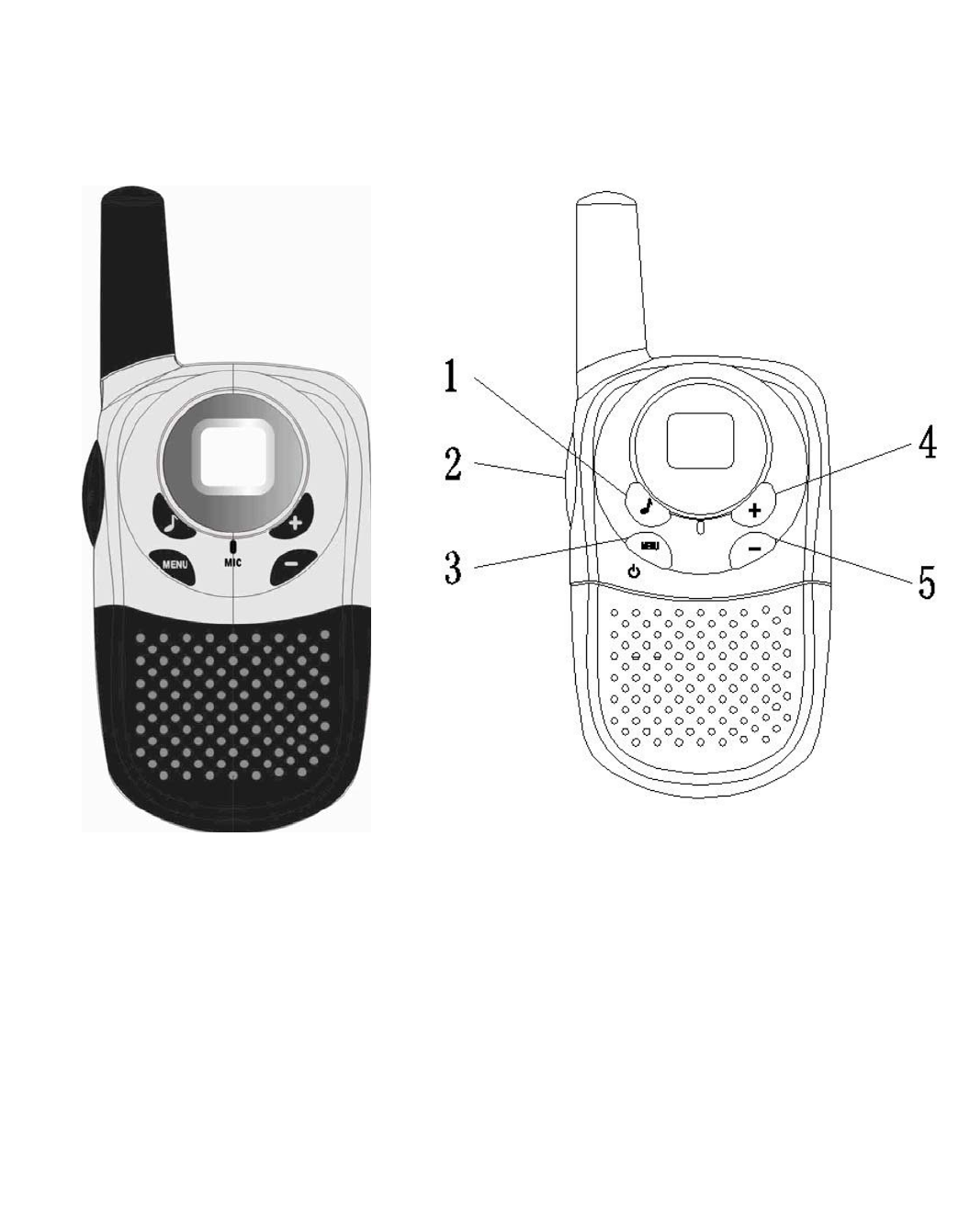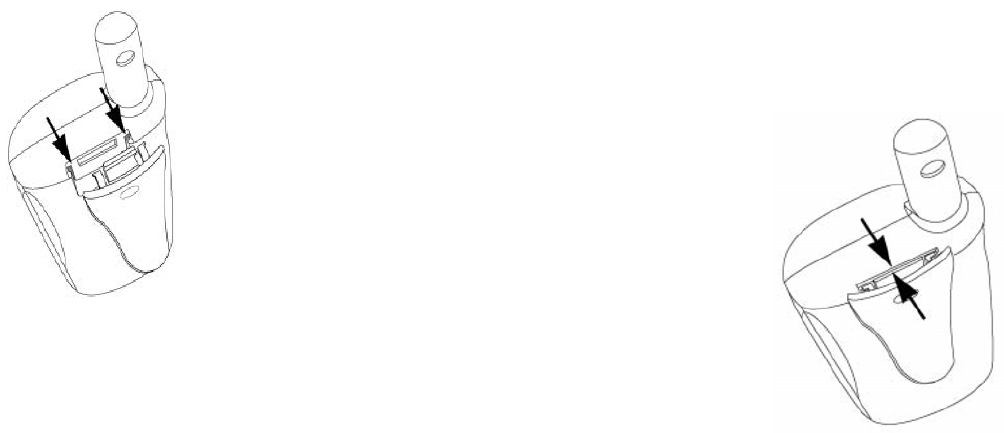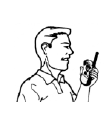Giant Electronics T2010 GMRS+FRS User Manual manual
Giant Electronics Ltd GMRS+FRS manual
User Manual
1 of 12
T2010
User Manual

2 of 12
T2010
1 Call Tone 4 Up key
2 PTT 5 Down key
3 Power on/off / menu

3 of 12
1. Turning Your Radio On And Off
To turn on, press and hold the ”PWR “ button until the radio chirps and the display all feature icons
that your radio has available for a brief period. The display will show the channel 1 -22 and
interference eliminator code 0 - 38. To turn off, press and hold “PWR” button until the display blank.
2. Adjusting Speaker Volume
When power up, Press “Up” or “Down“ button to adjust your volume to a comfortable listening level.
Press the “Up” button in standby mode to increase the speaker volume. The volume level is
displayed together with the volume icon “V”
Press the “Down” button to decrease the speaker volume.
3. Changing Channels
• Press “MENU” button once, the current channel number flashes on the display.
• Press “Up” or “Down“ button to change channel.
• Press “PTT” button to confirm the desired channel and return to receive mode.
RF Channel & Frequency
Channel Frequency Description Channel Frequency Description
1 462.5625 MHz FRS/GMRS 12 467.6625 MHz FRS
2 462.5875 MHz FRS/GMRS 13 467.6875 MHz FRS
3 462.6125 MHz FRS/GMRS 14 467.7125 MHz FRS
4 462.6375 MHz FRS/GMRS 15 462.5500 MHz GMRS
5 462.6625 MHz FRS/GMRS 16 462.5750 MHz GMRS
6 462.6875 MHz FRS/GMRS 17 462.6000 MHz GMRS
7 462.7125 MHz FRS/GMRS 18 462.6250 MHz GMRS
8 467.5625 MHz FRS 19 462.6500 MHz GMRS
9 467.5875 MHz FRS 20 462.6750 MHz GMRS
10 467.6125 MHz FRS 21 462.7000 MHz GMRS
11 467.6375 MHz FRS 22 462.7250 MHz GMRS
4. CTCSS (Continuous Tone Coded Squelch System)
The 2 digit CTCSS code corresponds to a specific tone frequency the radio emits. Two users, with
the same channel and CTCSS set can hear one another. They will not be able to hear anyone else
on the channel unless the other radios have the same exact CTCSS code enabled. The Radio has
38 CTCSS codes available.
• Press “MENU: button twice, the CTCSS code will flash on the LCD display.
• Press the “Up” button or the “Down” button to change to another code.
• Press “PTT” button to confirm your selection and return to the standby mode.
4 of 12
Any PMR set on the same channel can receive and listen to the conversation, also when the other
use a CTCSS code.
To disable CTCSS code, set the code to “0”
5. Call Tones
Your radio can transmit different call tones to other radios in your group so you can alert them that
you want to talk.
To setting the Call tone:
The Radio has 5 call tones
• With the radio on, press “Menu” button three times. The current call tone setting number flashes
and “C” will be displayed.
• Press “Up” button or the “Down” button to select another call tone.
• Press “PTT” button to confirm your selection and return to standby mode.
To Sending Call Tone:
• Press the “Call “ button briefly. The selected call tone will be transmitted for one time on the set
channel. The Call Tone will be repeated a maximum of 10 times while the “Call” button is pressed
and held.
To disable Call Tones, select “0”
6. Time-out Timer
The Time-out Timer feature helps extend battery life by preventing accidental transmission. The
radio will emit a continuous warning tone after “PTT” button is pressed for 60 continuous seconds
and will stop transmitting.
7. Channel Scan
Channel Scan performs searches for active signals in an endless loop from channel 1 to 22,
including CTCSS codes.
Activate channel scan:
• Press the “Menu” button four times.
• Press the “Up” button or “Down” button, until “Y” is displayed, to activate scanning.
• Press the “PTT” button to confirm your selection.
• When activity on one of the 22 channels is detected the channel scan will stop and you can listen
to the conversation on this channel.
• Press the “Up” button or the “Down” button to skip the channel.
• If no button is pressed and no activity has been detected, the channel scan will continue
automatically after 5 seconds.
You can not change the speaker volume in channel scan mode.
5 of 12
Nuisance Delete
If scan continuously stops on an undesired channel, press and hold ”+” or “-“
button for least 3 seconds, then release. This will temporarily remove the undesired channel from
the scan list.
To restore the channel to the scan list, turn the radio off and then on. You cannot remove your
home channel from the scan list (your home channel is the channel your radio was set to when you
activated scan).
Deactivate channel scan:
• Press the “Menu” button four times.
• Press the “Up” or the “Down” button, until “-“ is displayed, to deactivate scanning.
• Press the “PTT” button to confirm your selection
8. Keypad Lock
Only the “Call” button and the “PTT” button will work when keypad lock is activated.
Activate Key Pad Lock:
• Press “Menu” button for five times.
• Press “Up” button or “ Down” button to activate the key pad lock.
The key pad lock icon is displayed.
Deactivate Key Pad Lock
• In key pad lock mode, press the “Menu” button for 3 seconds.
• A beep will confirm the deactivation and the key pad lock icon will disappear.
9. Monitor Function
This functions allows you to monitor a set channel and CTCSS code for 15 seconds for any activity.
Activate monitor mode:
• Press the “Menu” button six times to start monitoring the channel activity, the set channel and
CTCSS code is displayed.
• Press the “Up” button to increase or the “Down” button to decrease the speaker volume level.
• Channel monitor automatically stops after 15 seconds.
Deactivate monitor mode:
• In monitor mode, press the “Menu” button or the “PTT” button to deactivate the monitor mode or
wait 15 seconds for monitoring to stop automatically.
10. Roger Beep On/Off
After the “PTT” button is released, the unit will send out a roger beep to confirm that you have
stopped talking.
To disable the roger beep:
• Turn the unit off.
• Press and hold the “Up” button while pressing the “Menu” button to turn the unit on.

6 of 12
To enable the roger beep, follow the same instructions.
11. Battery Meter
The battery meter located in the display indicates how much battery power you have remained. To
protect the rechargeable battery, the radio chirps every 10 minutes after releasing “PTT” when the
battery meter has one segment blink left.
12. Talking and Listening
Read this manual carefully before use.
Your radio has 22 channels. If you are in a group and you wish to talk to each other, all radios must
be set to the same channel and interference eliminator code (CTCSS). If you experience
interference and need to change channel, ensure that you change the channel and code of all
radios in your group.
• For maximum clarity, hold radio 5 to 7 centimeters from mouth.
• Press and hold “PTT” and speak into the microphone. The LCD Perimeter rectangle is on solid on
the display when transmitting.
• To receive messages, release “PTT”.
Attaching the Belt Clip (included)
Hook the belt clip into the notch at top of the radio and slide down until it clicks
into place.
To remove, squeeze the release latch together and
slide the clip up and away from the radio.
7 of 12
Safety and General Information
Important Information on Safe and Efficient Operation
Read This Information Before Using Your Radio
The information provided in this document supersedes the general safety information in user
guides published prior to December 1, 2002.
Transmit and Receive Procedure
Your two-way radio contains a transmitter and a receiver. To control your exposure and ensure
compliance with the general population/uncontrolled environment exposure limits, always adhere
to the following procedure:
Transmit no more than 50% of the time.
To transmit (talk), press the Push to Talk (PTT) button.
To receive calls, release the PTT button.
Transmitting 50% of the time, or less, is important because the radio generates measurable RF
energy exposure only when transmitting (in terms of measuring standards compliance).
Exposure To Radio Frequency Energy
Our two-way radio complies with the following RF energy exposure standards and guidelines:
United States Federal Communications Commission, Code of Federal Regulations; 47CFR
part 2 sub-part J
American National Standards Institute (ANSI) / Institute of Electrical and Electronic Engineers
(IEEE) C95. 1-1992
Institute of Electrical and Electronic Engineers (IEEE) C95. 1-1999 Edition
International Commission on Non-Ionizing Radiation Protection (ICNIRP) 1998
Ministry of Health (Canada) Safety Code 6. Limits of Human Exposure to Radio frequency
Electromagnetic Fields in the Frequency Range from 3 KHz to 300 GHz, 1999
Australian Communications Authority Radio communications (Electromagnetic Radiation –
Human Exposure) Standard, 2003
ANATEL ANNEX to Resolution No. 303 of July 2, 2002 “Regulation of limitation of exposure
to electrical, magnetic and electromagnetic fields in the radio frequency range between 9KHz
and 300GHz” and “Attachment to resolution #303 from July 2, 2002”
To assure optimal radio performance and make sure human exposure to radio frequency
electromagnetic energy is within the guidelines set forth in the above standards, always adhere to
the following procedures.

8 of 12
Portable Radio Operation and EME Exposure
Antenna Care
Use only the supplied or an approved replacement antenna. Unauthorized antennas,
modifications, or attachments could damage the radio and may violate FCC regulations.
DO NOT hold the antenna when the radio is “IN USE”. Holding the antenna affects the effective
range.
Two-way Radio Operation
When using your radio as a traditional two-way radio, hold the radio in a vertical
position with the microphone 1 to 2 inches (2.5 – 5 cm) away from the lips.
Body-Worn Operation
To maintain compliance with FCC/Health Canada RF exposure guidelines, if you wear a radio on
your body when transmitter, always place the radio in a Our supplied or approved clip, holder,
holster, case, or body harness for this product. Use of non-Our- approved accessories may exceed
FCC/Health Canada RF exposure guidelines.
If you do not use one of the our-supplied or approved body-wore accessories, and are not using the
radio held in the normal use position, ensure the radio and its antenna are at least 1 inch (2.5
cm) from your body when transmitting.
Data Operation
If applicable, when using any data feature of the radio with or without an accessory cable, position
the radio and its antenna at least 1 inch (2.5 cm) from the body.
Electromagnetic Interference/Compatibility
Note: Nearly every electronic device is susceptible to electromagnetic interference (EMI) if
inadequately shielded, designed, or otherwise configured for electromagnetic compatibility.
Facilities
To avoid electromagnetic interference and/or compatibility conflicts, turn off your radio in any facility
where posted notices instruct you to do so. Hospitals or health care facilities may be using
equipment that is sensitive to external RF energy.
Aircraft
When instructed to do so, turn off your radio when on board an aircraft. Any use of a radio must be
in accordance with applicable regulations per airline crew instructions.
Medical Devices - Pacemakers
The advanced Medical Technology Association recommends that a minimum separation of 6
inches (15 cm) be maintained between a handheld wireless radio and a pacemaker. These
recommendations are consistent with the independent research by, and recommendations of the
U.S. Food and Drug Administration. Persons with pacemakers should:
9 of 12
ALWAYS keep the radio more than 6 inches (15cm) from their pacemaker when the radio is
turned ON.
Not carry the radio in the breast pocket.
Use the ear opposite the pacemaker to minimize the potential for interference.
Turn the radio OFF immediately if you have any reason to suspect that interference is taking
place.
Medical Devices – Hearing Aids
Some digital wireless radios may interfere with some hearing aids. In the event of such interference,
you may want to consult your hearing aid manufacturer to discuss alternatives.
Other Medical Devices
If you use any other personal medical device, consult the manufacturer of your device to determine
if it is adequately shielded from RF energy. Your physician may be able to assist you in obtaining
this information.
Safety and General Use While Driving
Check the laws and regulations on the use of radios in the area where you drive. Always obey them.
When using your radio while driving, please:
Give full attention to driving and to the road.
Use hands-free operation, if available.
Pull off the road and park before making or answering a call if driving conditions so require.
Operational Warnings
For Vehicles with an Air Bag
Do not place a portable radio in the area over an air bag or in the air bag deployment area. Air bags
inflate with great force. If a portable radio is placed in the air bag deployment area and the air bag
inflates, the radio may be propelled with great force and cause serious injury to occupants of the
vehicle.
Potentially Explosive Atmospheres
Turn off your radio prior to entering any area with a potentially explosive atmosphere, unless it is a
radio type especially qualified for use in such area as “Intrinsically Safe.”
Do not remove, install, or charge batteries in such area. Sparks in a potentially explosive
atmosphere can cause explosion or fire resulting in bodily injury or even death.
Note: The areas with potentially explosive atmosphere referred to above include fueling areas
such as below decks on boats, fuel or chemical transfer or storage facilities, areas where
the air contains chemical or particles, such as grain, dust, or metal powders, and any other
area where you would normally be advised to turn off your vehicle engine. Areas with
potentially explosive atmosphere are often but not always posted.
Blasting Caps and Areas
To avoid possible interference with blasting operations, turn off your radio when you near electrical
blasting caps, in a blasting area, or in areas posted: “Turn off two-way radio.” Obey all sign and
instructions.
10 of 12
Operational Cautions
Antenna
Do not use any portable radio that has damaged antenna. If a damaged antenna comes into
contact with your skin, a minor burn can result.
Batteries
All batteries can cause property damage and / or bodily injury such as burns if a conductive
material such as jewelry, keys, or beaded chains touch exposed terminals. The conductive material
may complete an electrical circuit (short circuit) and become quite hot. Exercise care in handling
any charged battery, particularly when placing it inside a pocket, purse , or other container with
metal objects.

11 of 12
FCC Licensing Information
Your radio operates on General Mobile Radio Service (GMRS) frequencies and is subject to the
Rules and Regulations of the Federal Communications Commission (FCC). The FCC requires that
all operators using GMRS frequencies obtain a radio license before operating their equipment. To
obtain the FCC forms, please request Forms 605 and 159, which includes all forms and
instructions. If you wish to have the document faxed or mailed, or have questions, please use the
following contact information.
Changes or modifications not expressly approved by may void the user’s authority granted by the
FCC to operate this radio and should not be make. To comply with FCC requirements, transmitter
adjustments should be made only by or under the supervision of a person certified as technically
qualified to perform transmitter maintenance and repairs in the private land mobile and fixed
services as certified by an organization representative of the user of those services. Replacement
of any transmitter component (crystal, semiconductor, etc.) not authorized by the FCC equipment
authorization for this radio could violate FCC rules.
Note: Use of this radio outside the country where it was intended to be distributed is subject to
government regulations and may be prohibited.
This device complies with Part 15 of the FCC Rules. Operation is subject to the following two
conditions: (1) this device may not cause harmful interference, and (2) this device must accept any
interference received, including interference that may cause undesired operation.
NOTE: This equipment has been tested and found to comply with the limits for a Class B digital
device, pursuant to Part 15 of the FCC Rules. These limits are designed to provide reasonable
protection against harmful interference in a residential installation. This equipment generates, uses
and can radiate radio frequency energy and, if not installed and used in accordance with the
instructions, may cause harmful interference to radio communications.
However, there is no guarantee that interference will not occur in a particular installation. If this
equipment does cause harmful interference to radio or television reception, which can be determined
by turning the equipment off and on, the user is encouraged to try to correct the interference by one or
more of the following measures:
Reorient or relocate the receiving antenna.
Increase the separation between the equipment and receiver.
Connect the equipment into an outlet on a circuit different from that to which the receiver is connected.
Faxed
Contact the Fax-On-
Demand system at:
Mailed
Call the FCC forms
Hotline at:
Questions
Regarding FCC license
Contact the FCC at:
1-888-CALL-FCC
1-888-225-5322
Or: http://www.fcc.gov
1-800-418-FORM
1-800-3676
1-202-418-0177
12 of 12
Consult the dealer or an experienced radio/TV technician for help.